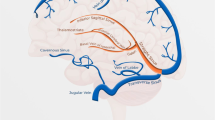Abstract
Retrospective review of patients with cerebral venous thrombosis (CVT) detected by 64-slice multidetector row computed tomography (MDCT). To evaluate the role of CT scan as the primary modality of imaging in suspected cases of CVT. Between October 2006 and September 2007, 53 patients, suspected to have CVT, underwent CT scan of the brain. Out of these, 33 patients were included in the study, who underwent non-contrast CT (NCCT), CT venous angiogram (MDCTA) and magnetic resonance venogram. Two blinded readers evaluated the NCCT and MDCTA. Final diagnosis was obtained after consensus reading of all the imaging by the two readers. Out of the total 33 patients, 20 patients were detected to have thrombosis of one or more of the cerebral venous sinuses or veins, at the concluding consensus reading. MDCTA together with NCCT could identify thrombosis in all of the 20 patients, i.e., 100% sensitivity and specificity. Sixty-four-slice MDCTA together with NCCT provided 100% sensitivity and specificity for the identification of CVT. It can be considered as a cost-effective and widely available, primary imaging modality in emergency situations.





Similar content being viewed by others
References
Bousser MG, Barnett HJM (1992) Cerebral venous thrombosis. In: Barnett HJM, Mohr JP, Stein BM, Yatsu FM (eds) Stroke pathophysiology, diagnosis and management. 2nd edn. Livingstone, New York, NY
Girot M, Ferro JM, Canhão P, Stam J, Bousser MG et al (2007) Predictors of outcome in patients with cerebral venous thrombosis and intracerebral hemorrhage. Stroke 38(2):337–342
Lemke DM, Hacein-Bey L (2005) Cerebral venous sinus thrombosis. J Neurosci Nurs 37(5):258–264
Rodallec MH, Krainik A, Feydy A, Hélias A et al (2006) Cerebral venous thrombosis and multidetector CT angiography: tips and tricks. Radiographics 26(Suppl 1):S5–S18, (discussion S42–S43)
Dullawar VA (2004) Multi-slice CT angiography: a practical guide to CT angiography in vascular imaging and intervention. Br J Radiol 77:27–38
Rubin GD (2001) Techniques for performing multidetector-row computed tomographic angiography. Tech Vasc Interv Radiol 4:2–14
Prokop M (2000) Multislice CT angiography. Eur J Radiol 36:86–96
Yuh WT, Simonson TM, Wang AM et al (1994) Venous sinus occlusive disease: MRI findings. Am J Neuroradiol 15:309–316
Corvol JC, Oppenheim C, Manai R et al (1998) Diffusion-weighted magnetic resonance imaging in a case of a cerebral venous thrombosis. Stroke 29:2649–2652
Keller E, Flacke S, Urbach H et al (1999) Diffusion and perfusion-weighted magnetic resonance imaging in deep cerebral venous thrombosis. Stroke 30:1144–1146
Ducreux D, Oppenheim C, Vandamme W et al (2001) Diffusion-weighted imaging patterns of brain damage associated with cerebral venous thrombosis. Am J Neuroradiol 22:261–268
Chu K, Kang DW, Yoon BW et al (2001) Diffusion-weighted magnetic resonance in cerebral venous thrombosis. Arch Neurol 58:1569–1576
Selim M, Fink J, Linfante I, Kumar S, Schlaug G, Caplan LR (2002) Diagnosis of cerebral venous thrombosis with echo-planar T2*-weighted magnetic resonance imaging. Arch Neurol 59(6):1021–1026
Ayanzen RH, Bird CR, Keller PJ et al (2000) Cerebral MR venography: normal anatomy and potential diagnostic pitfalls. AJNR Am J Neuroradiol 21:74–78
Kilic T, Ozduman KC, Avdar S et al (2005) The galenic venous system: Surgical anatomy and its angiographic and magnetic resonance venographic correlations. Eur J Radiol 56:212–219
Ameri A, Bousser MG (1992) Cerebral venous thrombosis. Neurol Clin 10:87–111
Biousse V, Bousser MG (1999) Cerebral venous thrombosis. Neurologist 5:236–249
Allroggen H, Abbott RJ (2000) Cerebral venous sinus thrombosis. Postgrad Med J 76:12–15
Greiner FG, Takhtani D (1999) Neuroradiology case of the day. Radiographics 19:1098–1101
Wetzel SG, Kirsch E, Stock KW, Kolbe M, Kaim A, Radue EW (1999) Cerebral veins: comparative study of CT venography with intraarterial digital subtraction angiography. AJNR Am J Neuroradiol 20(2):249–255
Teasdale E (2000) Cerebral venous thrombosis: making the most of imaging. JR Soc Med 93(5):234–237
Elliot K (2005) Fishman. Multidetector-row computed tomography to detect coronary artery disease: the importance of heart rate. Eur Heart J Suppl 7:G4–G12
Klingebiel R, Busch M, Bohner G et al (2002) Multi-slice CT angiography in the evaluation of patients with acute cerebrovascular disease-a promising new diagnostic tool. J Neurol 249:43–49
Klingebiel R, Zimmer C, Rogalla P et al (2001) Assessment of the arteriovenous cerebrovascular system by multi-slice CT. A single-bolus, monophasic protocol. Acta Radiol 42:560–562
Ertl-Wagner B, Hoffmann RT, Bruening R et al (2004) Multi-slice CT angiography of the brain at various kilovoltage settings. Radiology 231:528–535
Acknowledgment
Our sincere thanks to Chhaya, Prabhakar, and Yogesh, the technologists’ team, for their relentless work and support.
Declaration of originality, authorship, and competing interest on behalf of all authors of the manuscript
This manuscript is based on original work and had not been published in whole or part, in any print or electronic media. All persons listed as authors in the manuscript have made substantial contribution, so as to take public responsibility to it, in the production of this manuscript. No person who had contributed substantially to the production of this manuscript had been excluded from authorship. There is nothing to declare as competing interest for any of the authors including the corresponding author. The protocol for the research project has been approved by a Ethics Committee of the institution within which the work was undertaken and that it conforms to the provisions of the Declaration of Helsinki (as revised in Edinburgh 2000).
Author information
Authors and Affiliations
Corresponding author
Rights and permissions
About this article
Cite this article
Gaikwad, A.B., Mudalgi, B.A., Patankar, K.B. et al. Diagnostic role of 64-slice multidetector row CT scan and CT venogram in cases of cerebral venous thrombosis. Emerg Radiol 15, 325–333 (2008). https://doi.org/10.1007/s10140-008-0723-4
Received:
Accepted:
Published:
Issue Date:
DOI: https://doi.org/10.1007/s10140-008-0723-4




